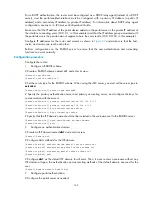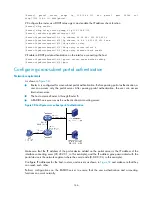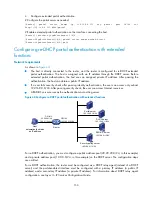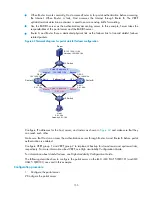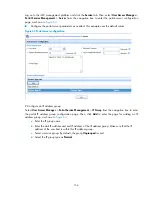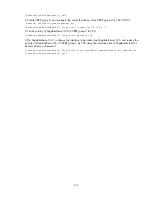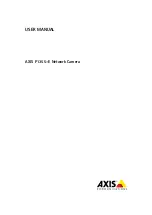
149
[Router-radius-rs1] server-type extended
# Specify the primary authentication server and primary accounting server, and configure the keys for
communication with the servers.
[Router-radius-rs1] primary authentication 192.168.0.112
[Router-radius-rs1] primary accounting 192.168.0.112
[Router-radius-rs1] key accounting radius
[Router-radius-rs1] key authentication radius
[Router-radius-rs1] user-name-format without-domain
# Configure the IP address of the security policy server.
[Router-radius-rs1] security-policy-server 192.168.0.113
[Router-radius-rs1] quit
2.
Configure an authentication domain.
# Create an ISP domain named
dm1
and enter its view.
[Router] domain dm1
# Configure AAA methods for the ISP domain.
[Router-isp-dm1] authentication portal radius-scheme rs1
[Router-isp-dm1] authorization portal radius-scheme rs1
[Router-isp-dm1] accounting portal radius-scheme rs1
[Router-isp-dm1] quit
# Configure
dm1
as the default ISP domain for all users. Then, if a user enters the username without the
ISP domain at logon, the authentication and accounting methods of the default domain are used for the
user.
[Router] domain default enable dm1
3.
Configure the ACL (ACL 3000 ) for resources on subnet 192.168.0.0/24 and the ACL (ACL 3001)
for Internet resources.
NOTE:
On the security policy server, specify ACL 3000 as the isolation ACL and ACL 3001 as the security
ACL.
[Router] acl number 3000
[Router-acl-adv-3000] rule permit ip destination 192.168.0.0 0.0.0.255
[Router-acl-adv-3000] rule deny ip
[Router-acl-adv-3000] quit
[Router] acl number 3001
[Router-acl-adv-3001] rule permit ip
[Router-acl-adv-3001] quit











